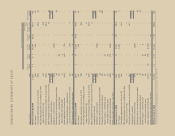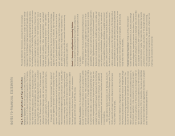Sara Lee 2011 Annual Report Download - page 77
Download and view the complete annual report
Please find page 77 of the 2011 Sara Lee annual report below. You can navigate through the pages in the report by either clicking on the pages listed below, or by using the keyword search tool below to find specific information within the annual report.
74/75 Sara Lee Corporation and Subsidiaries
corporation’s effective tax rate will occur over time as a result of
these and other factors which could materially change the estimated
cost of future repatriation actions.
• Tax legislation in the jurisdictions in which the corporation does
business may change in future periods. While such changes cannot
be predicted, if they occur, the impact on the corporation’s tax assets
and obligations will need to be measured and recognized in the
financial statements.
• The corporation has ongoing U.S. and foreign tax audits for
various tax periods. The U.S. federal tax years from 2007 onward
remain subject to audit. Fiscal years remaining open to examination
in the Netherlands include 2003 forward. Other foreign jurisdictions
remain open to audits ranging from 1999 forward. With few excep-
tions, the corporation is no longer subject to state and local income
tax examinations by tax authorities for years before 2005. The tax
reserves for uncertain tax positions recorded in the financial state-
ments reflect the expected finalization of worldwide examinations.
The corporation regularly reviews its tax positions based on the
individual facts, circumstances, and technical merits of each tax
position. If the corporation determines it is more likely than not that
it is entitled to the economic benefits associated with a tax position,
it then considers the amounts and probabilities of the outcomes
that could be realized upon ultimate settlement with a taxing author-
ity, taking into consideration all available facts, circumstances, and
information. The corporation believes that it has sufficient cash
resources to fund the settlement of these audits.
As a result of audit resolutions, expirations of statutes of
limitations, and changes in estimate on tax contingencies in 2011,
2010 and 2009, the corporation recognized tax benefits of $20 mil-
lion, $177 million and $21 million, respectively. However, audit
outcomes and the timing of audit settlements are subject to signifi-
cant uncertainty. The corporation estimates reserves for uncertain
tax positions, but is not able to control or predict the extent to which
tax authorities will examine specific periods, the outcome of exami-
nations, or the time period in which examinations will be conducted
and finalized. Favorable or unfavorable past audit experience in any
particular tax jurisdiction is not indicative of the outcome of future
examinations by those tax authorities. Based on the nature of
uncertain tax positions and the examination process, management
is not able to predict the potential outcome with respect to tax peri-
ods that have not yet been examined or the impact of any potential
reserve adjustments on the corporation’s tax rate or net earnings
trends. As of the end of 2011, the corporation believes that it is
reasonably possible that the liability for unrecognized tax benefits
will decrease by approximately $15 million to $40 million over the
next 12 months.
The corporation’s tax returns are routinely audited by federal,
state, and foreign tax authorities. Reserves for uncertain tax posi-
tions represent a provision for the corporation’s best estimate of
taxes expected to be paid based upon all available evidence recog-
nizing that over time, as more information is known, these reserves
may require adjustment. Reserves are adjusted when (a) new infor-
mation indicates a different estimated reserve is appropriate; (b) the
corporation finalizes an examination with a tax authority, eliminating
uncertainty regarding tax positions taken; or (c) a tax authority does
not examine a tax year within a given statute of limitations, also
eliminating the uncertainty with regard to tax positions for a specific
tax period. The actual amounts settled with respect to these exami-
nations were the result of discussions and settlement negotiations
involving the interpretation of complex income tax laws in the context
of our fact patterns. Any adjustment to a tax reserve impacts the cor-
poration’s tax expense in the period in which the adjustment is made.
As a global commercial enterprise, the corporation’s tax rate from
period to period can be affected by many factors. The most significant
of these factors are changes in tax legislation, the corporation’s
global mix of earnings, the tax characteristics of the corporation’s
income, the timing and recognition of goodwill impairments, acqui-
sitions and dispositions, adjustments to the corporation’s reserves
related to uncertain tax positions, changes in valuation allowances,
and the portion of the income of foreign subsidiaries that is expected
to be remitted to the U.S. and be taxable. It is reasonably possible
that the following items can have a material impact on income tax
expense, net income and liquidity in future periods:
• The company’s international operations provide a significant
portion of the company’s cash flow from operating activities, which is
expected to require the company to continue to repatriate a significant
portion of the cash generated outside of the U.S. The repatriation
of these funds has and is expected to continue to result in a higher
effective income tax expense and cash taxes paid. The tax provision
associated with the repatriation of foreign earnings for both contin-
uing and discontinued operations in fiscal years 2011, 2010 and
2009 was $214 million, $574 million and $58 million, respectively.
In 2010, the tax expense for repatriation of foreign earnings was
significantly higher due to the corporation’s decision to no longer
reinvest overseas earnings primarily attributable to existing overseas
cash and the book value of the household and body care businesses.
In its determination of which foreign earnings are permanently rein-
vested, the corporation considers numerous factors, including the
financial requirements of the U.S. parent company, the financial
requirements of its foreign subsidiaries, and the tax consequences
of remitting the foreign earnings to the U.S. Variability in the
























